Friends
Why Japan Is Good For Your Mental Health
Why visiting Japan is good for your soul.
Posted January 20, 2020
As a travel writer, I frequently wonder about how and what to write about travel. How can I contribute to the wellbeing and peace of our shared planet? One of the best ways, I think, is to write about places and things that are good for peace of mind, feelings of wellness, and inspiration. So … let’s look at Japan.
1) ANA Airways: Flying There
As soon as my husband Paul and I settled into our seats with the noodle-thin Japanese passengers around us, the safety video began and it was performed by fully costumed Kabuki actors! Wearing white face paint and stylized masks they slid into seats, buckled in, and stoically dealt with emergency evacuation orders as Samurai warriors. For sliding down the chute they transformed into 19th-century polychrome prints. And then, off the screen and in the aisles, the entire cabin crew bowed to welcome us. When it was time to eat there was a costume change for the crew. They donned pink and blue apron-like dresses for serving food. No wonder All Nippon Airways is the airline so many Asian people fly.
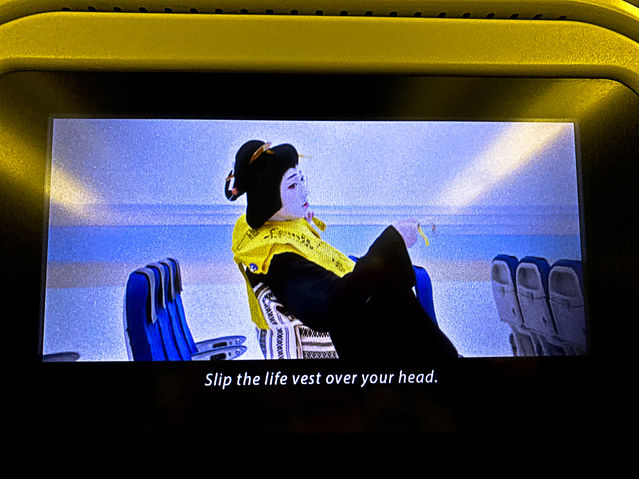
2) Bunraku in Osaka
There may be a more refined form of performance art in the world, but I have never seen it. Perhaps you have heard about the Bunraku puppeteers that manipulate life-size puppets and remain visible throughout the performance. Well, two of them are visible but covered head-to-toe in black hoods and black clothes. The third is the master puppeteer, and his face is visible as he brings the puppets to life. The puppets are so emotional, so “real,” so beautifully expressive that they are more alive than some people I know. And to the right of the stage, one man voices all of the roles, female and male, young and old, without ever looking at the puppets or the puppeteers. It is like an entire opera being sung and spoken by one person. And next to him is a shamisen (three-string traditional Japanese instrument) player. The singer and the musician are so in synch they are like one person.
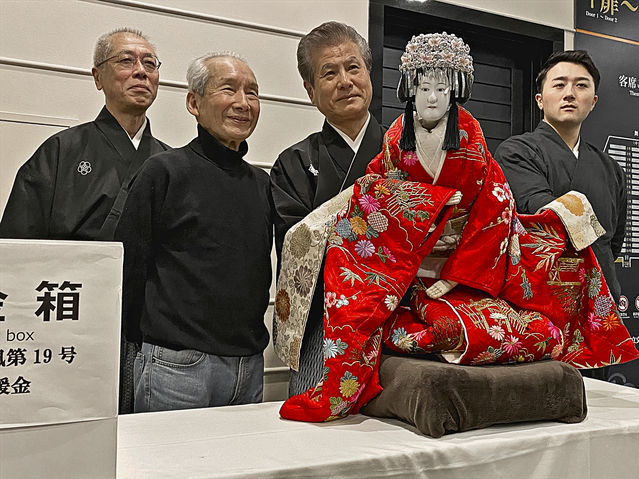
A Bunraku puppeteer must begin training by age 15, or he is considered too old to ever become a master in his lifetime. It takes ten years just to master manipulating the feet. Ten years for the hands. With all the body parts to master, it requires a lifetime. The three who work each puppet have to breathe together as one organism. They are not allowed to show any emotion, as all of it must be poured into the puppet.
The story on stage starts slowly and then builds to high drama. The performance is, by turns, graceful, forceful, timid, aggressive, and lyrical. It lasts four and a half hours, with breaks. You may rent a headset with a simultaneous English translation. You can buy food in the theatre and eat it at your seat. I could not take my eyes off the performers, and I was grateful that I could experience Bunraku at its birthplace: the National Bunraku Theatre of Osaka.
3) Kyoto? Of Course

Almost every world traveler who visits Japan goes to Kyoto, and although it is a historic, culturally fascinating, beautiful city, I am also sad to report that it is heavily over-touristed. Sometimes you are cheek to jowl with tourists who crowd the streets. When you visit marvels like the Golden Temple at sunset or the Inari Shrine with its 1,000 blazing orange-red torii gates (some say there are more than 10,000, but who’s counting?), you have to construct a little invisible cocoon around yourself so you are isolated for a moment from the crowds. We went during the turning-of-the-leaves in autumn, which, like cherry blossom season in the spring, is one of the busiest times of the year. The Japanese go crazy for those multi-hued leaves, and they head to Kyoto in droves for the magnificent displays of nature.
We started out staying at a boutique Kyoto hotel near the main train station, where I jokingly told my friends that our room was the size of two potatoes. There wasn’t even room to open a suitcase unless it was hauled onto the bed. We were invited, instead, to stay at the Apartment Hotel Mimaru and we jumped at the chance. It is very well located, affordable, we could walk to almost all of the attractions, and it was a real apartment—with a small but fully-equipped kitchen, a dining table with foam-padded cushions, a sleeping area (with a bed that could fit two sumo wrestlers), and of course a bathroom with a Toto toilet that does everything for you except the reading. We were so pleased with the place that we hosted a dinner party for new Japanese friends.
We were also invited to experience two tours, and we thought it would be a good way to learn, explore, and have knowledgeable guides who were capable of dodging the crowds.
First was the three-hour Arigato Japan Food Tour. Our tour leader was a very affable, long-time Welsh rock-‘n-roller named Russ who performs in Japan. He knew exactly which stands to stop at in the famous Nishiki market. How about a brightly colored soap made from a vegetable called conyaku? You can wash your hands with it and it is so clean it can be eaten. Somewhat tastier was marinated octopus stuffed with quail egg.
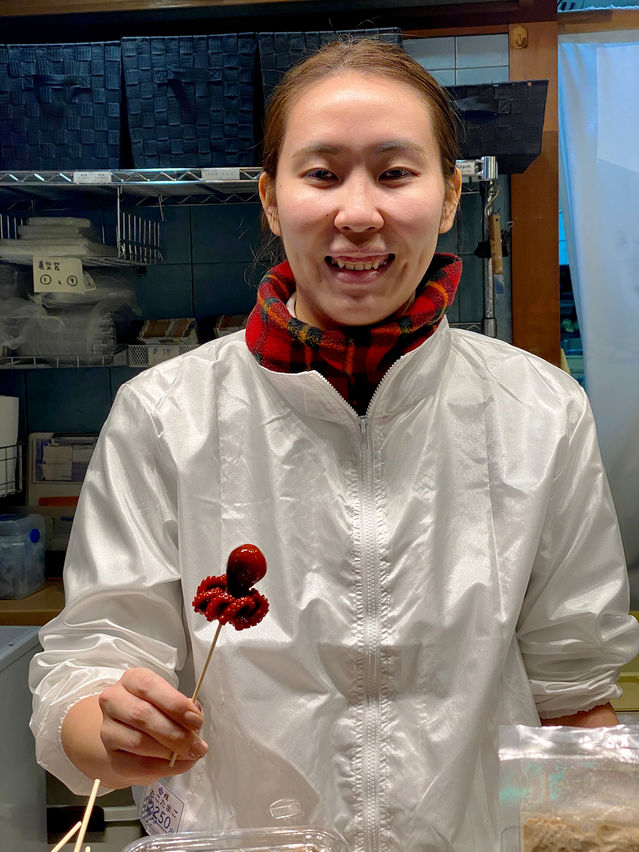
You’d probably love visiting a knife shop that started making swords in 1560 and then, in the 17th and l8th centuries, turned to knives that were used for woodcarvings in Buddhist temples. Today their knives are for cooking, and the left-handed ones are very popular.
Then it was time to eat. Russ led us to a private dining room for a languorous, varied, traditional Japanese meal, where we could experience some of the foods we had sampled and learn about others.
Our second tour was run by Context Travel, and it involved about six miles of walking. The theme was Shintoism and Buddhism, and John, our very knowledgeable guide, led us to temples and shrines that are a photographer’s dream. He explained that the temples are Buddhist and the shrines are Shinto and made sure we understood the difference.
Along the way, from temples to shrines, John gave us a history of Japan and a history of Shinto and Buddhism. He stopped in front of a big poster that listed which ages are “bad” or really difficult for men (25, 42, and 61) and which ages are hard for women (19, 33, and 37). Ring a bell, anyone?
One of the highlights was a shrine where visitors stood in line to purify their hands and lips in water from a sacred spring where a hermit monk once lived. The shrine included a landscaped rock garden where our guide said that meditating monks can see themselves in the arrangements. Well, I must be a monk because I looked at those wavy lines and rock islands and mountains in the sand and I could see myself there. We only had five minutes, so I could also see myself leaving.
5) Hiroshima with Yumi
Two years ago, when we were in Japan, we had a smart, caring, savvy guide named Yumi, and we have stayed in touch with her. We were very moved when Yumi invited us to stay at her house in Hiroshima, and we had the pleasure and honor of experiencing life as it’s lived by a traditional yet modern Japanese couple.
Yumi’s mother is a survivor of the atomic blast in 1945, and she recently told her story for the first time. I will be writing about that soon, and I will wager that you will be deeply moved and will never say the word “nuclear” again without shuddering and thinking of Yumi’s mother.
Yumi drove us into the countryside to see a vibrant, exciting, heavily-costumed Kagura performance. Kagura was the basis for Noh, Kabuki, and Bunraku, and the show was riveting.
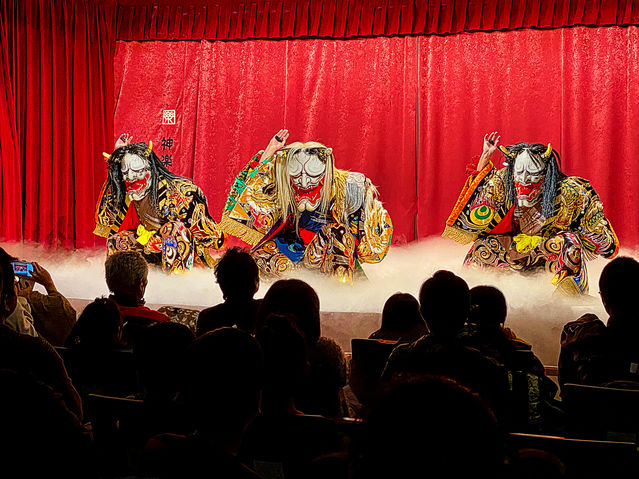
She also took us to visit some of the islands of the Seto Inland Sea, and each has a story, a history, an array of fabulous old traditional houses. The view of the Seto sea and its islands was a moody panorama of grays and blacks and light grays and dark grays because we visited on a cloudy day.
We really love Yumi, and if you need a very special guide in Hiroshima and Western Japan, you can contact her. (s-abe@mte.biglobe.ne.jp)
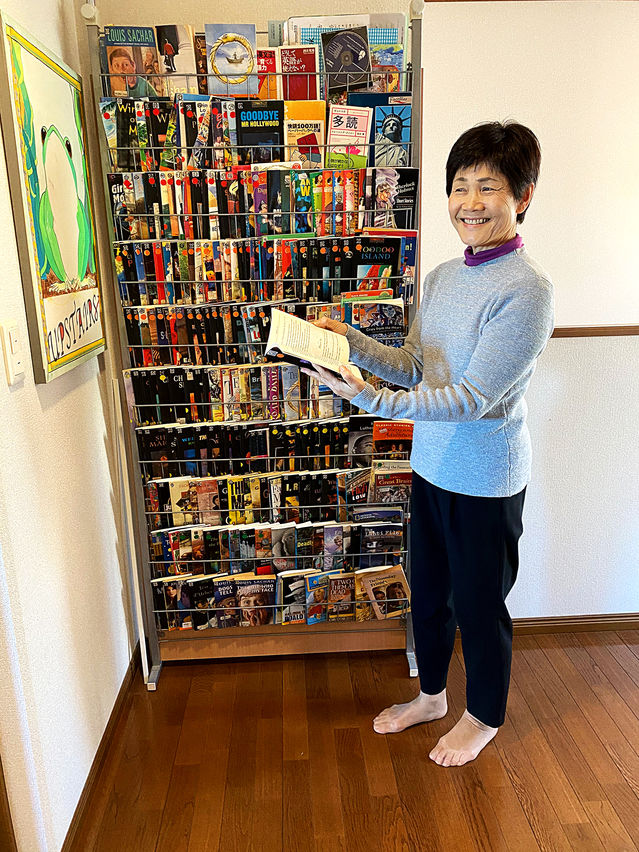
6) The Art of Tokyo
Don’t ask. Just go to the Mori Art Museum in Roppongi Hills in Tokyo. It’s likely beyond the edge of what you have seen anywhere else. The museum is pregnant with some of the most provocative and disturbing and exciting exhibits I have ever seen in a museum.
The first part of the current exhibit is about cities of the future as envisioned and created by minds around the world that are interested in sustainability and climate change and architecture and environment and the intersection of them all. Some of the structures presented are made from paper, wood, mushrooms, or 3D printed materials that can pull water from the air and stand close to each other to create shade in hot climates.
And then the exhibits got much more disturbing. There is a more-than-life-size statue of what it would look like if humans mated with orangutans and had babies that look part orangutan and part human.

There are models of three babies in cases and they have been genetically altered to give them certain advantages like enhanced breathing ability, more endurance, and greater temperature tolerance. They are intentional deformities parents can choose. There is fashion of the future with a different outfit for each person on the planet. Cockroaches, in many colors, make up future food. A machine of the future sits with you when you are dying and consoles you. An older hairdresser converses with her young robot client about philosophy and aging. Humans have mechanical parts. There is no escape except if you stop to pet a robotic dog that clearly enjoys being touched. Some of the visitors come with their own robotic pets. The future is here.
And you’ll also want to visit the Mori Digital Art Museum, where every young visitor to Japan seems to gravitate. You wander through spaces that are seemingly filled with flying butterflies or lined with gorgeous bamboo trees and you walk into the projections and interact with them and they flow from one room to the next and into the corridors and then you climb up real poles and walk through a forest of mushrooms that are artificial and it’s all interactive and visual and projected on spaces with uneven surfaces and there’s an athletic park and it’s quite a feat of digital projection with animals along the walls and they seem so real but they are digital creations and it all flows nonstop like this run-on sentence.
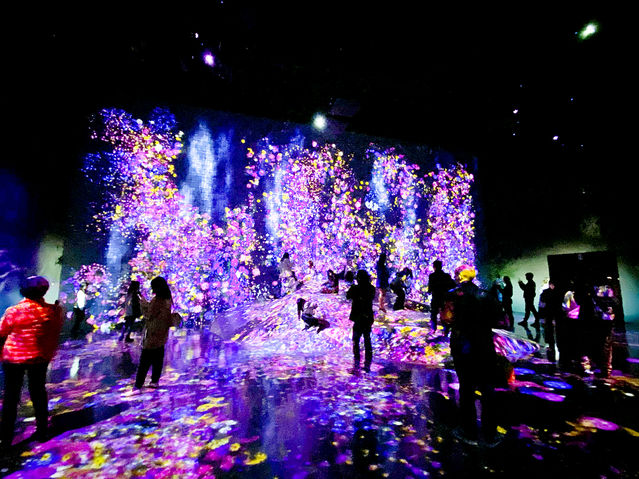
A trip to Japan does not have to be expensive, but if you want a five-star customized experience in Japan, and you want someone to put together a trip of a lifetime, our top recommendation is Julia Maeda: julia@tokyopersonalised.com.
7) The Japan You Don’t Know About—Tohoku and Niigata
You know how you want to tell people about something, but you don’t want to spoil it? Tohoku is like that. Few tourists have discovered this culturally rich area that is on the main island and only a few hours from Tokyo by high-speed rail. In fact, only 1.5 percent of visitors to Japan venture there. Until this part of the trip, we were on our own and had very little planned in advance. It was all about discovery and wonderful happenstance. But for the Tohoku and Niigata portion, we were with other travel journalists and photographers and the itinerary had been developed for us over many long months. From country lunch to the Miyagicyo distillery for a whiskey tasting, we were soused and dined. Local specialties include rice balls in green bean paste and fish pops—squid and other fish are served on a popsicle stick. And “Chie,” one of our guides, performed rakugoka for us and tried out her routines as we drove in a van. It’s a 400-year old tradition of comic storytelling. Think stand-up with props.
The town of Kakunodate in Akita prefecture, which once was a castle town, has some of the best Samurai architecture in the country. At night, we walked down the lane of Samurai houses in the quiet of early winter. Snow piled on the pointed thatched roofs and weighed down the branches of century-old cherry trees. The darker the sky got the more the snow glistened and the gates and stones in front of houses looked more mysterious.
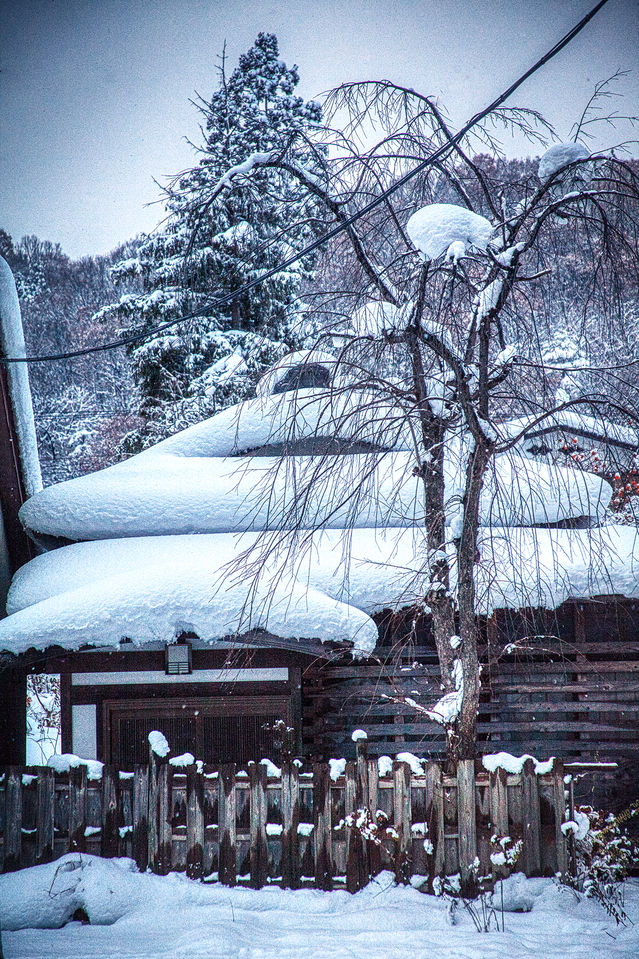
When we returned in the morning, we visited one upper-class Samurai house where the current owner, who guides visitors, still lives. He descends from 380 years of Samurai. His ancestor was an accountant to the local lord in the castle, but in times of war he put down his pen and took up the sword.
We arrived in the merchant area of Akita city in time for udon lunch. Udon noodles are eaten cold here, and the dish was first commissioned by a feudal lord 350 years ago; he wanted the cold noodles to be thin, long, and firm. They were a luxury then and they are still pricey today because they take a long time to make and involve multiple processes. The udon is served on a bamboo platter, accompanied by tiny bowls of this and that. You pour their contents into a lacquer bowl filled with a complex and delicious broth. Next, you try to lift up a small bunch of thin udon noodles with your chopsticks and dunk them in the broth. Then you pull the noodles out and slurp slurp slurp. The lunch was served with a light and fluffy vegetable tempura and with small river fish.
For those of you who like quirk, at the Shinzan Shinto shrine in Oga, people spit into Kleenexes and shape them into a little wad. They throw the wad at the guardian figures in front of the shrine, aiming for the part of their bodies that needs healing. And for connection to the healing power of nature, visitors walk to the 1100-year-old tree. If you stand still and put your hand on the tree, it seems to be alive and breathing. The shrine is connected to Namahage, so of course, we wanted to know what that was.
Also in Oga, at the only museum in Japan, and probably in the world, that is dedicated to the Namahage, we were introduced to a brilliant display of masks and costumes worn by the ogre-like mountain deities. They are bogeymen who visit houses to scare children who don’t obey their parents, and parents who are lazy, if such a thing exists in workaholic Japan. And then we experienced a visitation by two scary Namahage; luckily they didn’t know that I once took two hours off from work.
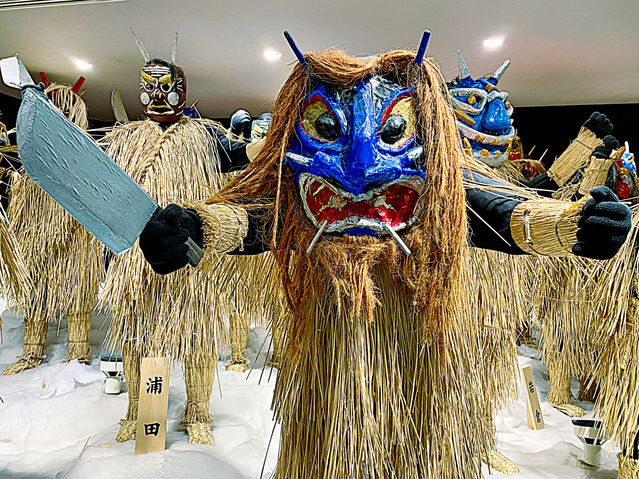
In Nigaata, one factoid may be of interest to you sake lovers. There are 1400 sake breweries in Japan and 98 of them are in Niigata. ’Nuff said.
One of the most magical experiences of the trip was an overnight at Jonji temple with monks from the Soto sect of Buddhism. Usually, Japanese fishermen who want to pray for plentiful fish and safety at sea stay at the temple. We were the first foreign visitors. We ate vegetarian fare and learned to clean our dishes with … pickles. They are great at dislodging residue that is left on the bowls. At 5 the next morning, we attended a prayer service where they prayed for us, intoning our names. The ceremony involved gorgeous ritual and room-rattling taiko drums.
There were optional parts of the trip, and, except for one other woman, I was the only journalist who opted to do a blacksmithing workshop. You can never again say I don’t know how to make an iron nail. It was personal, fiery, and I love doing things I have never done before. I nailed it, so to speak, and would highly recommend you do the same.
8) Yamagata Prefecture and Little Tree
Two years ago, Paul and I were privileged to spend several days in isolation with a Yamabushi master. The Yamabushi, mountain monks, were so powerful they were said to be able to control the weather. For 1500 years, the practices remained secret, and Master Hoshino, the man we studied with, decided the world is such a mess it’s time to make the practice available to others.
First, it was offered to Japanese, and then, since a monk I call Little Tree (his real name is Tak) could speak English, it was offered to westerners. Paul and I were the first two journalists/photographers to have the training and initiation. It is an ascetic practice, which means it can be physically very demanding. You go through a symbolic death and are reborn. But you have to trust me on this: if we did it, you can too. The experience with Master Hoshino is transformative, and you will remember it for the rest of your life (https://www.yamabushido.jp).
Dear friends and colleagues and future friends, I wish for you a trip to Japan this year or any other year of your choosing. The kindness, politeness, helpfulness, and grace of the people will move you to gratitude or even to tears. It is a trip that is good for the soul.
xxx




